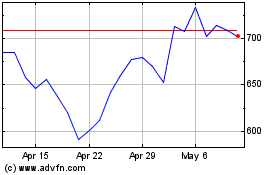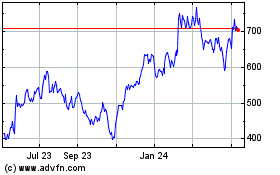Texas Instruments Gains Analog Leverage With National Semi Buy
April 05 2011 - 1:40PM
Dow Jones News
Texas Instruments Inc.'s (TXN) pricey $6.5 billion deal to buy
National Semiconductor Corp. (NSM) strengthens the company's analog
chip holdings, but questions remain as to how disruptive the merged
entity will be to the $42 billion analog market.
The deal adds 12,000 products to Texas Instruments' analog
business, which will now represent more than half of the company's
revenue. The combination of National Semiconductor will enable TI
to compete better in areas that it is currently not strong, such as
industrial power management, which comprises about half the total
analog market, according to one research firm.
"Analog and particularly analog catalog portfolios take a long
time to build," said Texas Instruments Chairman and Chief Executive
Rich Templeton. "In any given year, TI introduces about 500 new
analog products. With this acquisition, we add 12,000 products all
at once."
He said National Semiconductor's exposure to the industrial
market will benefit TI, whose power-management products are geared
more toward portable devices.
"The bottom line is that the combination of TI and National
means we can engage with customers in application segments where we
have no or minimal engagement today," Templeton said.
Analog chips--which take real-world signals, such as sound and
light, and convert them to digital signals--are used in products
ranging from cellphones to industrial equipment.
Among those power-management companies that could feel pressure
from a combined TI and National Semiconductor include Microchip
Technology Inc. (MCHP), STMicroelectronics NV (STM) and Power
Integrations Inc. (POWI). Other large analog companies like Analog
Devices Inc. (ADI), Maxim Integrated Products Inc. (MXIM) and
Linear Technology Corp. (LLTC) also could feel heighened
competition.
Texas Instruments' acquisition of National Semiconductor creates
a "analog power house" with a "substantial advantage" in the
marketplace, Cowen & Co. analyst John Barton said as he
downgraded his rating on Analog Devices and Maxim to neutral from
outperform.
However, analysts note, it is hard to displace rivals quickly in
the analog market because customers tend to have longstanding
relationships with their chip companies and usually have little
need to displace them.
TI, though, sees cost savings of $100 million on an annualized
run rate from the merger simply from consolidating the company's
sales forces and cross-selling each company's products. Also, TI
said that because the companies have parts that fit together
easily, it expects the deal to add to earnings quickly.
"The numbers work," Templeton said. "I've always said that we
would not enter into a sizeable acquisition unless it made us a
better, stronger supplier to our customers and that the numbers
made sense both near term and long term."
The deal is not expected to prompt consolidation in the analog
sector, though many stocks were getting a boost on hopes for more
merger activity. Intersil Corp. (ISIL) jumped 10%, while Semtech
Corp. (SMTC) grew 7.4%.
Because of the cyclical nature of the chip industry, and the
perennial need to invest in new equipment, semiconductor companies
tend to carry a lot of cash on their books. This forces potential
acquirers to pay a hefty premium on any deal. For example, TI's
offer price was 78% above National Semiconductor's current
valuation.
Many analog companies "are probably too well-capitalized to be
easy absorption targets," Gartner analyst Steve Ohr said.
In addition, IDC analyst Mali Venkatesan said mergers between
larger analog companies don't happen often because of the
competitive nature of the business.
"I don't think in the tech field, especially the analog or the
chip business where innovation continues to be a pretty important
factor, that there is necessarily some force of consolidation,"
Texas Instruments' Templeton said.
-By Shara Tibken, Dow Jones Newswires; 212-416-2189;
shara.tibken@dowjones.com
Monolithic Power Systems (NASDAQ:MPWR)
Historical Stock Chart
From Mar 2024 to Apr 2024

Monolithic Power Systems (NASDAQ:MPWR)
Historical Stock Chart
From Apr 2023 to Apr 2024
